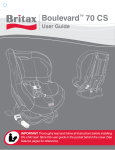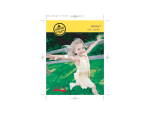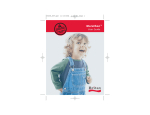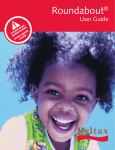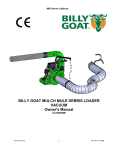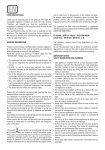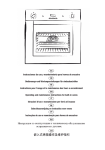Download Britax Handle with Care
Transcript
Recall Information Child restraints could be recalled for safety reasons. You must register this restraint to be reached in a recall. Send your name, address and the restraint's model number and manufacturing date to: Britax Child Safety, Inc. 460-R Greenway Industrial Drive Fort Mill, SC 29715 HANDLE WITH CARE™ or call For infants weighing from 5 pounds to 20 pounds 1 (888) 4 BRITAX For use rear-facing only For recall information, call the U.S. Government's Auto Safety Hotline at 1-800-424-9393. In the DC area call 1 (202) 366-0123. Fill out the registration card attached to your Handle With Care and mail it in today! BRITAX Child Safety, Inc. 460-R Greenway Industrial Drive Fort Mill, SC 29715 Tel: (888) 4BRITAX #1 PN 000-013 4/99 Table of Contents For Your Information . . . . . . . . . . . . . . . . . . . . . . . . . . . . . 1 Your Child’s Protection Is in Your Hands . . . . . . . . . . . . . . . 1 Airbag Warning. . . . . . . . . . . . . . . . . . . . . . . . . . . . . . . . . 2 Pre-term and Low-Birthweight Infants . . . . . . . . . . . . . . . . 2 A Message to Parents and Caregivers. . . . . . . . . . . . . . . . . 3 Incorrect Use Is Common. . . . . . . . . . . . . . . . . . . . . . . . . . 3 Incompatible Seat Locations . . . . . . . . . . . . . . . . . . . . . . . 4 Important Warnings. . . . . . . . . . . . . . . . . . . . . . . . . . . . . . 5 Incompatible Belts and Vehicle Seats. . . . . . . . . . . . . . . . . . 6 For Your Information This product fulfills the requirements of the U.S. Federal Motor Vehicle Safety Standard 213 and is certified for use in motor vehicles and for use in aircraft. It is designed for infants weighing between 5 lbs. (2.3 kg) and 20 lbs. (9 kg), and measuring up to 26 inches (66 cm) in height. This infant restraint MUST be used rear-facing. Please read and understand the information in this booklet before using your infant restraint. Store the booklet in the pocket located in the back of the restraint, just above the rocker base. Consult it often to make sure you are using the restraint correctly. Becoming Familiar with Handle With Care . . . . . . . . . . . 8 - 9 Securing Your Infant. . . . . . . . . . . . . . . . . . . . . . . . . 10 - 13 Installing with Lap Belt Only and Lap & Shoulder Belt . . . . . . 14 - 16 How to Anchor Perfect-Fit Tether . . . . . . . . . . . . . . . 16 - 18 How to Release & Refasten Perfect-Fit Tether . . . . . . 18 - 20 Attaching Canopy . . . . . . . . . . . . . . . . . . . . . . . . . . . . . . 21 Care and Cleaning. . . . . . . . . . . . . . . . . . . . . . . . . . . . . . 22 Buckle Problems . . . . . . . . . . . . . . . . . . . . . . . . . . . . . . . 23 Types of Belts Vehicles Have. . . . . . . . . . . . . . . . . . . . . . . 25 Using Child Seat in an Airplane . . . . . . . . . . . . . . . . . . . . 26 Register and Warranty . . . . . . . . . . . . . . . . . . . . . . . 27 - 29 Your Child’s Protection Is in YOUR Hands! Failure to follow each of the instructions contained in this booklet can result in your child striking the vehicle interior during a sudden stop or crash. In a severe crash your child could be ejected from the vehicle into the roadway. Secure this child restraint with a vehicle belt as specified in this instruction booklet and in your vehicle owner’s manual and secure your child in the restraint with the harness system provided. Recall Information. . . . . . . . . . . . . . . . . . . . . . . . Back Cover 1 Airbags A Message to Parents and Caregivers NEVER place this infant restraint into a front passenger seat that has an airbag. An airbag inflates with explosive force in a split second. It can do so even in a minor, fender-bender-type mishap. When the bag deploys, it strikes the back of the child restraint right behind the infant’s head. This violent blow will cause fatal or catastrophic injuries to the child. Older children who ride facing forward are also at risk and are safer in the back seat. IMPORTANT: Owners of vehicles with front passenger side airbags should refer to their vehicle owner’s manual for child restraint installation instructions. You can’t always tell if the passenger seat has an airbag. If you are renting, driving, or riding in someone else’s vehicle, don’t take chances! Take the time and trouble to find out before you place a child in the front passenger seat. Some vehicles have side-impact airbags. Follow vehicle manufacturer instructions. Pre-term infants weighing less than five pounds, may have difficulty breathing when placed in a semi-upright position. Consult your doctor before using your Handle With Care™. For the first few weeks you may have to use a safety device that allows your infant to lie flat. 2 Before using your Handle With Care™, please take the time to read this manual. Get to know the restraint and follow instructions carefully. Also make sure that everyone who will be driving your child knows how to use it. This includes babysitters, grandparents and friends. It is recommended that you give a demonstration on the correct use of the Handle With Care™ to anyone who will be using it, even if that person is familiar with other child restraints. There are differences from brand to brand and from one model to another. The Handle With Care™ may have features other child restraints don’t have. Incorrect Use Is All Too Common Safety checks carried out in many parts of the country have shown that most safety restraints are not used correctly. This can lead to tragedy. Investigations of crashes involving children reveal that the majority of children who were hurt were not correctly protected at the time of the crash. A mistake in the way the restraint is attached to the vehicle or in the way the child is secured in the restraint could put the child at risk. Even used correctly, a child restraint cannot always prevent injuries. Some crashes are so violent that they may cause critical or fatal injuries. Correct use of a safety device can help reduce the severity of injuries. According to accident statistics, children are safer when properly restrained in the rear seating positions than in the front seating position. 3 Incompatible Seating Locations Important Warnings ■ Seating Locations That Must NOT Be Used for a Child Restraint ■ ■ ■ ■ ■ NEVER install this restraint on a vehicle seat that faces sideways. NEVER install this restraint on a vehicle seat that faces rearward. ■ ■ ■ 4 NEVER leave a child unattended in this restraint, even for just a few moments. The child could find a way to become tangled in webbing and choke, tip the restraint over, or other dangers. Keep a watchful eye on your baby if you temporarily use the Handle With Care™ in the house. NEVER place the restraint on a table or other raised surface. It could fall off! Everyone must buckle up! In a crash, unrestrained occupants could injure those who ride protected. Secure the Handle With Care™ in your vehicle even when it is not occupied. In a crash, an unsecured child restraint may injure other occupants. NEVER take your child out of the restraint or remove harness straps while the vehicle is moving. If the child is in need of attention pull off the highway into a safe rest area. Hot Parts! In hot, sunny weather, check the fabric and the buckle before placing your child in the restraint. When parking in the sun for long periods, cover the restraint with a towel. DO NOT use a child restraint in a seat or with a seat back that folds down, unless these are latched and secure. Some seat backs are designed to lock in a crash. Check your vehicle owner’s manual. Adjust the head restraint of the seat in which the child restraint is installed to its lowest position. 5 Incompatible Seat Belts Seat Belts and Vehicle Seats NOT Suitable for Child Restraints To provide effective crash protection, a child restraint must be firmly secured on the seat of the vehicle. Some belts and some seating positions make this impossible. Read and follow your vehicle’s owner’s manual. If a child restraint shifts around as you drive, it could be out of the correct position at the moment a crash occurs. This could lead to the protection engineered into the device being lowered. For that reason some belts and some vehicle seats should not be used at all. DO NOT use a belt that has the lap belt and the shoulder belt sewn to the latch plate.* (Figure 1). DO NOT use a belt that has the lap and shoulder portions attached to the door* (Figure 3). DO NOT use a lap belt if it’s accompanied by a shoulder belt that runs on a motorized track.* (Figure 2). DO NOT use a belt that comes out of the seat cushion more than 2 inches in front of the seat crack.* (Figure 4). DO NOT use a vehicle seat that’s scooped out or has a hump.* * In most vehicles you’ll be able to find a seating location that allows you to install your child restraint correctly. If not, your vehicle owner's manual has information on adapting belts for use with a child restraint. In some cases the dealership can order and install a special belt. 6 Fig 1 Fig 2 Motorized Fig 3 Belts on Door Fig 4 7 Becoming Familiar with Your Handle With Care™ Carrying Handle Upper and Lower Shoulder Slots Becoming Familiar with Your Handle With Care™ Perfect-Fit Tether™ Buckle Canopy Handle Release Button 5 Point Harness Buckle Perfect-Fit Tether™ Harness Release Button Level Indicator Label Base Rocker Lap Belt Guides Lock-Off Tether Hook D-Ring * Infant Chest Clip Not Shown 8 9 Securing Your Infant in the Handle With Care™ Figure 5 1. Shoulder straps (Figure 5) must be threaded through slots at shoulder level or lower. For a newborn use the lowest slots. As the baby grows taller, switch the straps to the upper slots. 2. The infant must wear clothing that leaves the legs free so buckle strap can be correctly positioned between the legs. The Handle With Care™ comes to you with the harness straps in the lower slots, ready to use for your newborn. Securing Your Infant in the Handle With Care™ Press Release Figure 7 Figure 8 3. Release the buckle by pressing down on the red button. 4. Open infant chest clip by lifting tab and threading seat belt through it. Note: the appearance of the chest clip may vary from figure 8 above. 5. Place your infant in the Handle With Care™, buttocks first, making sure that its back is in contact with the restraint. There should be no gaps under the baby. 6. Place the harness straps over the infant’s shoulders. Bring the two tongues together and insert them into the buckle (Figure 9). Continued on Page 12. 10 11 Securing Your Infant in the Handle With Care™ Continued from Page 11. 7. Listen for the click to make sure that the buckle is securely latched. (Figure 10). If you don’t hear it, open the buckle and try again. Double-check the locking mechanism: Pull up on the straps. If the buckle releases, turn to Page 24 for help. 8. To adjust harness length, press the harness release button. (Figure 11). • To shorten, pull on the narrow strap that’s attached to the shoulder harness. • To lengthen, pull out shoulder straps with one hand while holding down the harness release button with the other (Figure 12). 9. The infant chest clip should be secured at arm pit level . Securing Your Infant in the Handle With Care™ 10. For the first few weeks, fill gaps around sides of the infant’s shoulders and head with rolled towels or blankets to provide side support. 11. When harness straps are fastened and adjusted, you may place a blanket or quilt over the baby. But don’t put anything underneath the child. Press Button To Lengthen Pull to Shorten Figure 11 Figure 9 Figure 12 Figure 10 12 13 Installing Your Handle With Care in the Vehicle™ Installing Your Handle With Care in the Vehicle™ Select a suitable seating location for your Handle With Care™. The center rear seat usually has a lap belt that locks. Some newer cars now have lap and shoulder belts in the center seat. Turn to Page 25 for instructions on how to use such a belt. A B Installing the Handle With Care™ with a Lap Belt Only or Lap & Shoulder Belt 1. Adjust the Handle With Care™ to its stable position by lowering the stabilizer feet until they lock (Figure 15). 2. Place the restraint rear-facing on the seat of the vehicle. The carrying handle can stay locked in the fully upright position marked A (Figure 16). 3. Adjust the base of the Handle With Care™ so it is level on the seat of the vehicle, the way it would be resting on the floor in your home. Refer to level indicator line on the side of seat shell as a guide. If the vehicle seat slopes back, the restraint will position your infant too upright. This could allow the head of a young baby to fall forward. 4. To achieve a level position on the seat of your vehicle, you may have to wedge a tightly rolled towel under the baby’s foot area of the restraint. But be careful not to tilt it back too far. That could be dangerous! The correct maximum recline angle is 45 degrees (Figure 17). 5. Open the lock-off on the left side of the child seat. (Figure 18). 6. Secure the Handle With Care™ by inserting the seat belt through the open lock-off and into the two belt guides and buckling it. To tighten the belt, gently rock the restraint side to side while you pull 14 Figure 15 Pushbutton (Both sides) Figure 16 45° (Parallel with ground or vehicle floor.) Figure 17 Figure 18 on the end of the lap belt only or the shoulder belt. Once the belts are tight, close the clamping arm, move the tab over until the lockoff is closed. (Figure 19). If the belt locks, the restraint will be securely installed. If doesn’t, turn to Page 25 to find out what you can do to lock the belt. 15 Installing Your Handle With Care in the Vehicle™ 7. If the stabilizer feet don’t make contact with the seat of the vehicle, release the belt a little and fill the gaps with small towels. Then tighten the belt again. Belt Guide Lock-Off Figure 19 How to Anchor the Perfect-Fit Tether 1. Find the Perfect-Fit Tether located on the back of the seat near the head area. 2. Check to make sure the latch is inserted into the buckle. 3. The length of the Perfect-Fit Tether can be extended by lifting the silver metal tab and pulling the web strap. 4. The end of the Perfect-Fit Tether has a metal ring (D-ring). Take this metal ring (D-ring) and find a location underneath the vehicle seat in front of the child restraint to wrap it around. How to Anchor the Perfect-Fit Tether Vehicle Seat Your Handle with Care should already be installed with the vehicle belts in the rearward facing position according to the instruction booklet. Buckle Perfect-Fit Tether™ Silver metal tab D-ring Hook 16 5. You are looking for any structural metal part. The best way is to feel underneath the vehicle seat directly in front of or to one side of the Handle With Care for the following: a. Seat frame bar that the strap can be wrapped around b. Seat mounting rail that is bolted to the floor of the vehicle c. A fixed vehicle seat belt anchor to the floor d. Vehicle seat leg that is bolted to floor 17 How to Anchor the Perfect-Fit Tether How to Release and Refasten Perfect-Fit Tether 6. Take the D-ring and loop the strap around the metal anchor 7. Take the hook and clip it around the D-ring 8. Once attached, lift up on strap, relieving the slack in the belt to achieve a more recline position but no more than 45 degrees. Refer to the red line on the side of the seat to make sure it is level with the vehicle floor. It is OK to have the tether at an angle. 18 To remove the Handle With Care from the vehicle, hold the back of the Handle with Care and press the red buckle button on the Perfect-Fit Tether and undo the vehicle safety belts. The Perfect-Fit Tether should remain on the floor board of your vehicle. With the handle in the upright position, and locked, the Handle With Care can be carried out of the vehicle. 19 How to Release and Refasten Perfect-Fit Tether Attaching Canopy Figure 23 When reinstalling the infant restraint in the vehicle, repeat the steps for Installing the Handle With Care with a Lap Belt Only or Lap & Shoulder Belt. The Perfect-Fit Tether is fastened by inserting the buckle into the latch plate. If the length of the Perfect-Fit Tether makes it difficult to buckle, lengthen the strap by lifting the silver metal tab and pulling the web. Once buckled, tighten by pulling the strap. Figure 24 1. Place handle in upright position by squeezing the side handle release buttons 2. Spread open the canopy and lay it over the head area of the cover to the handle. The velcro strips should be on the same side as the handle with the velcro strips facing towards the infant restraint. 3. Wrap and fasten the velcro around both sides of the handle. (Figure 23) 4. Then fasten the velcro to the back of the cover. (The positioning velcro patches are located on the cover in the rear of the child restraint. For a tighter fit, roll the canopy under 1⁄2” before attaching.) 5. To reverse the direction of the canopy, unattach the velcro that is fastened to the rear of the cover. * 6. Roll the canopy over the handle so it is now hanging over child’s leg area. 7. Tighten the position by fastening the velcro patches to outside left and right of front cover (Figure 24). * The reverse direction of the canopy can be used to block the sun from shining in the child’s eyes. Also, this position assists in scooping air-conditioned air towards the child. 20 21 The Buckle Care and Cleaning DO NOT take the harness apart when cleaning the seat. It is unnecessary and dangerous to do so. DO NOT use solvents, cleaning fluids or chlorine bleach as these would weaken the harness webbing, the cover fabric and the plastic shell. Harness Straps Add a few drops of mild dishwashing detergent to a bowl of warm water. Use a cloth dipped in the water to wipe the webbing. You may use a soft brush to remove caked-on soil. Rinse with clean water and pat dry. The Cover The cover can be machine-washed in warm water (100° F, 40° C). Select a short, gentle wash cycle. If cover is very soiled, allow it to soak for half an hour. Spin dry at a lowspeed setting. If you prefer, wash it by hand. DO NOT put the cover into the dryer, not even on a low temperature setting. Dryer heat would shrink the fabric so cover would no longer fit. Air dry, out of direct sunlight. 22 Foreign objects, including food, milk, and juice, can accumulate in the buckle. This could become a hazard if it interferes with the locking mechanism. Never use oil or sprays! To clean the buckle, follow these steps: 1. Slide the cover off the lower part of the shell. 2. Remove the strap that has the buckle attached to it by pushing the narrow end of the metal plate (slide) up through the slot. (Figure 20). 3. Immerse the buckle in warm water with some dishwash ing liquid added to it. Soak for at least 30 minutes, longer if possible, preferably Figure 20 overnight. 4. Flush out loosened debris under running water (lukewarm never hot), then shake out water. Allow to air dry with the buckle opening facing down. A hair dryer used on a cool setting or a fan will speed up the drying process. Try the buckle to make sure it works. 5. Re-insert buckle strap by first threading it through the cover and then through the opening in the shell. Make sure that the strap is not twisted. 23 Troubleshooting What Kinds of Belts Does Your Vehicle Have? Problems with the Buckle Most problems relating to the buckle are due to the accumulation of dirt, juice, or milk. This can lead to the tongues: • Failing to lock with an audible click • Ejecting slowly when the release button is pressed • Being difficult to insert (you can feel resistance) • Not locking into the buckle, but ejecting again. These problems can usually be corrected by cleaning (see Page 23). It’s best to clean the buckle from time to time to keep it in good working condition. Never use oils or sprays! Important: If the buckle’s tongues of your Handle With Care™ can not be inserted, fully press down the release button of the buckle, and reinsert. Your child’s life could depend on the two tongues locking into the buckle with an audible click. Warning: In a crash, the Handle With Care™ could sustain structural damage. Although you may not notice any damage, the infant restraint should be replaced. Need Assistance? If you have questions regarding the Handle With Care™ or have difficulty installing it correctly, call our toll-free Help Line: 1 888 4 BRITAX 24 A child restraint has to be tightly secured to the seat of a vehicle. It’s important to become familiar with the belts in your vehicle and get to know how to lock them. Some lap/shoulder belts have locking latch plates. Others have free-sliding latch plates that keep the belt loose while you’re driving, but a mechanism in the belt anchor would lock the belt in a crash. This system is safe for adults, but for an infant restraint the belt must be tightly locked from the start. The rear center seat usually has a locking lap belt which, once tightened, stays tight. In some vehicles center seats now have combination lap/shoulder belts. These may be especially suitable for your Handle With Care™. Lap/shoulder belts have one of the following: 1. A locking latch plate which, once the belt is tightened, will keep it tight. 2. A free-sliding latch plate with a special mechanism that allows the belt to be “switched” from one that’s loose to one that locks. For information on how to lock the belt, check the label on the belt webbing and read the vehicle owner’s guide. 3. A belt with a free-sliding latch plate that has no built-in locking mechanism. You will need to use built in lock-off on the side of the seat. 25 How to Make Seat Belts Work with Child Restraints At times the buckle may be too close to the belt guide of the child restraint, so that the belt cannot be tightened sufficiently. At other times the belt release mechanism is kept in the “open” position, so the buckle won’t lock and the belt stays loose. In some vehicles turning the latch plate one half-turn (180 degrees) will disable the release mechanism and allow the belt to lock. This doesn’t work in all vehicles. In some the latch plate can’t be locked into the buckle this way. Using Child Seat In An Airplane Your Handle With Care is certified for use on aircraft (see label on seat). Since airlines have some restrictions about the use of child seats, notify the airline ahead of time to tell them you intend to bring the seat on board. For the safety of your child, use the infant seat in forward facing aircraft seats only. (Infant facing rearward.) Follow the installation instructions as previously described. Figure 21 Register Your Handle With Care™ Child restraints could be recalled for safety reasons. You must register this restraint to be reached in a recall. Send your name, address and the restraint’s model number and manufacturing date to: Britax Child Safety, Inc. 460-R Greenway Industrial Drive Fort Mill, SC 29715 or call toll-free: 1 888 4 BRITAX. For recall information, call the U.S. Government’s Auto Safety Hotline at 1-800-424-9393 (202-366-0123 in D.C. area) Fill out the postage-paid registration card attached to your Handle With Care™ and MAIL IT TODAY! Illustration shows Handle with Care correctly installed in window seat of an aircraft. 26 27 Warranty Warranty This Infant Restraint was manufactured by Britax Child Safety, Inc., Fort Mill, SC. (Britax Model 191) Britax Child Safety, Inc. (“Britax”) warrants this product to the original retail purchaser as follows: LIMITED ONE YEAR WARRANTY. This product is warranted against defective materials or workmanship for one year from the date of original purchase. Your exclusive remedy for this Warranty is that Britax will, at its option, provide repair or replacement components for this product or refund the original purchase price of the product. Britax reserves the right to discontinue or change fabrics, parts, models or products, or to make substitutions. To make a claim under this Warranty, you must contact your Britax retailer or Britax Customer Service Department, 460-R Greenway Industrial Drive, Fort Mill, SC 29715, or call Britax at 1(888) 427-4829. Proof of purchase required. PLEASE COMPLETE AND MAIL THE PRE-ADDRESSED OWNER REGISTRATION CARD WITHIN THIRTY (30) DAYS OF PURCHASE TO EXPEDITE WARRANTY CLAIMS AND TO EVIDENCE THE ORIGINAL DATE OF PURCHASE. LIMITATION OF DAMAGES. The Warranty and remedies as set forth are exclusive and in lieu of all others, oral or written, express or implied. In no event will Britax or the retailer selling this product be liable to you for any damages, including incidental or consequential damages, arising out of the use or inability to use this product. LIMITATION OF WARRANTIES AND OTHER WARRANTY TERMS AND STATE LAW RIGHTS. ANY IMPLIED WARRANTIES, INCLUDING IMPLIED WARRANTIES OF MERCHANTABILIY AND FITNESS FOR A PARTICULAR PURPOSE, SHALL BE LIMITED TO THE DURATION AND TERMS OF THE EXPRESS WRITTEN WARRANTY. SOME STATES DO NOT ALLOW LIMITATIONS ON HOW LONG AN IMPLIED WARRANTY LASTS OR THE EXCLUSION OF LIMITATION OF INCIDENTAL OR CONSEQUENTIAL DAMAGES, SO THE ABOVE LIMITATIONS MAY NOT APPLY TO YOU. THIS WARRANTY GIVES YOU SPECIFIC LEGAL RIGHTS, AND YOU MAY HAVE OTHER RIGHTS WHICH VARY FROM STATE TO STATE. Neither Britax or the retailer selling this product authorized any person to create for it any other warranty, obligation, or liability in connection with this product. WARRANTY LIMITATIONS. This Warranty does not include damages which arise from negligence, misuse or use not in accordance with the product instruction guide. 28 29



















